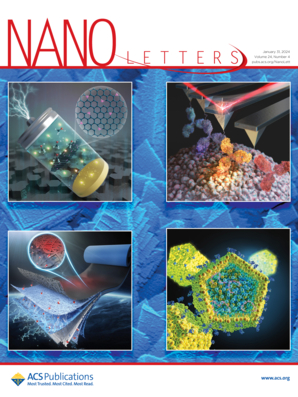Polarization and Charge-Separation of Moiré Excitons in van der Waals Heterostructures
IF 9.6
1区 材料科学
Q1 CHEMISTRY, MULTIDISCIPLINARY
引用次数: 0
Abstract
Twisted transition metal dichalcogenide (TMD) bilayers exhibit periodic moiré potentials, which can trap excitons at certain high-symmetry sites. At small twist angles, TMD lattices undergo an atomic reconstruction, altering the moiré potential landscape via the formation of large domains, potentially separating the charges in-plane and leading to the formation of intralayer charge-transfer (CT) excitons. Here, we employ a microscopic, material-specific theory to investigate the intralayer charge-separation in atomically reconstructed MoSe2–WSe2 heterostructures. We identify three distinct and twist-angle-dependent exciton regimes including localized Wannier-like excitons, polarized excitons, and intralayer CT excitons. We calculate the moiré site hopping for these excitons and predict a fundamentally different twist-angle-dependence compared to regular Wannier excitons - presenting an experimentally accessible key signature for the emergence of intralayer CT excitons. Furthermore, we show that the charge separation and its impact on the hopping can be efficiently tuned via dielectric engineering.

范德瓦尔斯异质结构中莫伊里激子的极化和电荷分离
扭曲的过渡金属二卤化物(TMD)双层膜表现出周期性的摩尔势,可以在某些高对称性位点捕获激子。在小扭转角度下,TMD 晶格会发生原子重构,通过形成大域来改变摩尔电势图,从而有可能在平面内分离电荷并导致形成层内电荷转移(CT)激子。在这里,我们采用一种微观的、针对特定材料的理论来研究原子重构 MoSe2-WSe2 异质结构中的层内电荷分离。我们发现了三种不同的、与扭转角度相关的激子机制,包括局域万尼尔样激子、极化激子和层内 CT 激子。我们计算了这些激子的摩尔位点跳变,并预测它们与普通的万尼尔激子相比具有根本不同的扭转角度依赖性--这为层内 CT 激子的出现提供了实验上可获得的关键特征。此外,我们还展示了电荷分离及其对跳电的影响可以通过介电工程进行有效调整。
本文章由计算机程序翻译,如有差异,请以英文原文为准。
求助全文
约1分钟内获得全文
求助全文
来源期刊

Nano Letters
工程技术-材料科学:综合
CiteScore
16.80
自引率
2.80%
发文量
1182
审稿时长
1.4 months
期刊介绍:
Nano Letters serves as a dynamic platform for promptly disseminating original results in fundamental, applied, and emerging research across all facets of nanoscience and nanotechnology. A pivotal criterion for inclusion within Nano Letters is the convergence of at least two different areas or disciplines, ensuring a rich interdisciplinary scope. The journal is dedicated to fostering exploration in diverse areas, including:
- Experimental and theoretical findings on physical, chemical, and biological phenomena at the nanoscale
- Synthesis, characterization, and processing of organic, inorganic, polymer, and hybrid nanomaterials through physical, chemical, and biological methodologies
- Modeling and simulation of synthetic, assembly, and interaction processes
- Realization of integrated nanostructures and nano-engineered devices exhibiting advanced performance
- Applications of nanoscale materials in living and environmental systems
Nano Letters is committed to advancing and showcasing groundbreaking research that intersects various domains, fostering innovation and collaboration in the ever-evolving field of nanoscience and nanotechnology.
 求助内容:
求助内容: 应助结果提醒方式:
应助结果提醒方式:


